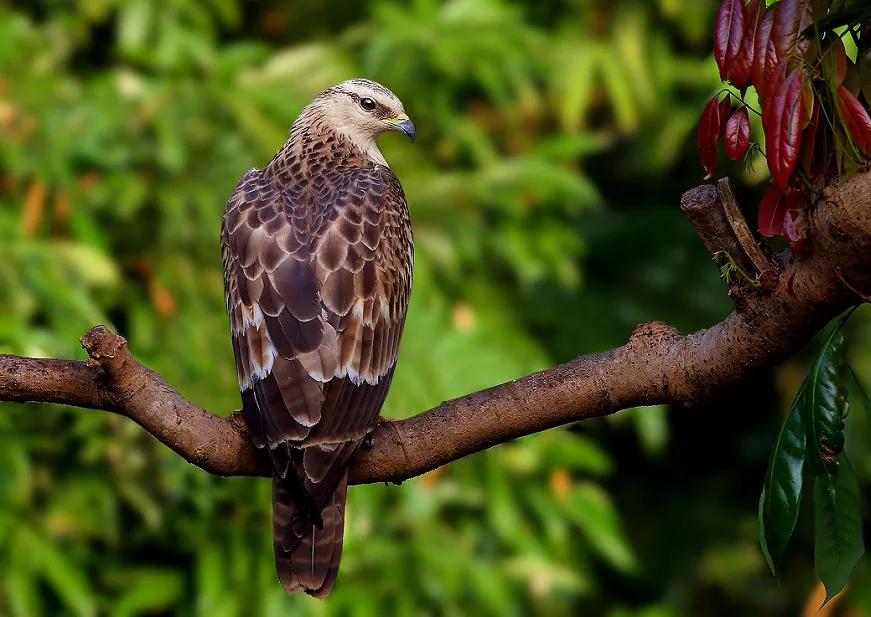The crested honey buzzard (Pernis ptilorhynchus) is a bird of prey in the family Accipitridae. As a medium-sized raptor, their size ranges between 50–60 cm (20–24 in). They are also known as the Oriental, Asiatic, or Eastern honey buzzard. The name is derived from its diet, which consists mainly of the larvae of bees and wasps extracted from honey combs.
What does crested honey buzzard look like
The crested honey buzzard is a medium-sized raptor with a dark brown to dark brown top and short, hard, scaly feathers on the side of the head, which are relatively thick and dense, which is one of its unique characteristics. The occiput of the head is usually distinguished by a short black crest. The iris is golden yellow or orange red, very beautiful. The mouth is black, the feet and toes are yellow, and the claws are black. The upper body is usually dark brown, the side of the head is gray, the throat is white, with black central stripes, and the rest of the lower body is tan or chestnut brown, with light reddish brown and white horizontal bands arranged alternately and thick black central stripes. The primary flight feathers are dark gray with black tips, the underwing feathers are white or gray with black horizontal bands, and the tail feathers are gray or dark brown with 3-5 dark broad band spots and off-white wavy horizontal spots. The crested honey buzzard’s body color varies greatly, but it can be distinguished from other raptors by the short and hard scale-like feathers on the side of the head and several dark broadband spots on the tail feathers. Its crest looks like a “phoenix crown” on the top of its head, which is where the Crested honey buzzard’s name comes from.
Crested honey buzzard habitat
It inhabits broad-leaved forests, coniferous forests, and mixed forests at different altitudes, especially in sparse forests and forest margins. Sometimes it also moves in small forests such as villages outside forests, farmland, and orchards.
Crested honey buzzard living habit
Some of the crested honey buzzards are resident birds and some are migratory birds, but they are relatively rare. Except for Hainan Island, all the birds distributed in China are summer migratory birds. They migrate from the beginning of April to the end of April in spring, and migrate away from the end of September to the end of October in autumn. It is usually active alone, and occasionally gathers in small groups in winter. The flight is sensitive and characteristic, and most of them fly with flapping wings. After flapping its wings a few times, it glides for a long time, with its wings stretched flat and soaring high into the sky. It often flaps its wings quickly to fly from one tree to another, and occasionally soars over the forest, or glides slowly, calling while flying, short and short, like whistling. Sometimes it can also be seen resting on the treetops of tall trees or on the branches and forks of the lower parts of trees in the forest.
What do Crested honey buzzards eat
Feeds mainly on wasps, wasps, bees, and other bees, but also other insects and insect larvae, and occasionally small snakes, lizards, frogs, small mammals, rodents, birds, bird eggs, and young birds sex food. They usually hunt in flight and can hunt small birds such as finches. Although bees have venomous stings that can even kill people, the hummingbirds regard them as food, not only like to eat the adults of bees, but also eat their larvae, eggs, as well as honey and beeswax etc. Crested honey buzzards mostly forage on trees or on the ground in the forest. They often use their claws to dig honeycombs on the ground, just like chickens planing food, pecking at various foods in the hives.
Distribution area of Crested honey buzzard
Distributed in Siberia, China, Japan, North Korea, India, Bangladesh, Cambodia, Brunei, India, Indonesia, Iran, South Korea, Malaysia, Myanmar, Philippines, Singapore, Thailand and other places.
Mode of reproduction
Nests are built on tall trees, mostly with dead branches and leaves as nest materials, sometimes using the old nests of buzzards or goshawks. Eggs are laid from late May to June, 2-3 eggs per nest, light grayish yellow with reddish brown spots. The hatching period is 30-35 days, and the brooding period is 40-45 days. The breeding season is from April to June. During courtship, both male and female birds glide in the air, then descend rapidly, and then hover slowly, with the two-winged elephants folded behind their backs 6-7 times. Nests on broad-leaved or coniferous trees, the height of the nest from the ground is 10-28 meters. The nest is mainly composed of dead branches, slightly concave in the middle, disc-shaped, with a few grass stems and blades inside, and sometimes the old nests of other raptors such as kites and goshawks are also used. Each nest lays 2-3 eggs, generally 2 eggs. Eggs are brick red or tan with brown spots.


 Facebook
Facebook  Instagram
Instagram  Youtube
Youtube 